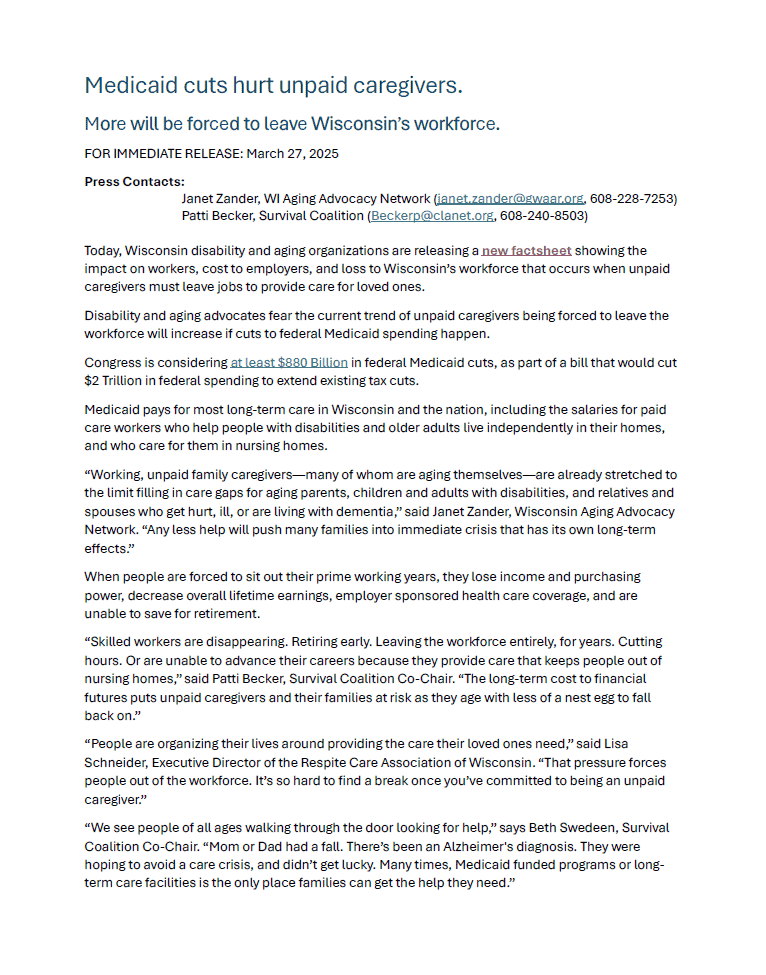Fact Sheet and Press Release



SOURCES
Council on Aging
- employees lose up to $3 trillion in wages and benefits while employers lose $17-33 billion to absenteeism and turnover.
Trualta
- The caregiving landscape is dominated by family members who provide unpaid assistance to their loved ones, often because they have no choice. AARP estimates that in 2021, family caregivers provided 36 billion hours of care valued at $600 billion,
- Paid caregivers are simply too expensive for most families, and the home care workforce shortage means they are not available to families who can afford them.
- Family caregivers lose $522 billion in wages annually, according to the Rand Corporation.
- Ten million caregivers aged 50 and older will lose a total of $3 trillion in wages, pensions, retirement funds and other benefits due to their caregiving duties
S & P Global 2023 AARP survey
- 67% of family caregivers have difficulty balancing their jobs with caregiving duties.
- 27% of working caregivers have shifted from full-time to part-time work or have reduced hours, 16% have turned down a promotion.
- 16% have stopped working entirely for a period of time — and 13% have changed employers — in order to meet caregiving responsibilities.
Federal Reserve Bank of Minnesota
- Full-time caregiving is one of the biggest reasons why adults don’t work.
- In the Upper Midwest, about 20 percent of voluntary part-time workers say they’re working part time due to child care or family issues.
World Economic Forum
- The $6 trillion US care economy comprises both paid and unpaid services provided to populations who are unable to independently support themselves.
- With historic labour shortages and economic challenges, US growth is at risk unless business and government leaders address the growing care crisis.
- If the care economy continues to operate without improvement, the US stands to lost $290 billion in GDP in the year 2030 and beyond.
- Yet that is just the mid-range scenario. Extreme forecasts put the GDP loss at about $500 Billion in the year 2030
- Unpaid care workers leaving their own jobs to backfill care that would have otherwise been provided by an aforementioned paid care worker.
- For every 10 paid caregivers who leave the workforce, one person in another part of the economy is forced to leave the workforce to backfill as a result.
Guardian Life
- There are 53 million US adults who care for a spouse, elderly parent or relative, or special-needs child.2That’s up from 43.5 million in 2015, and includes caregivers who also work full-time jobs.3
- Since most (61%) US households are dependent on two incomes to remain financially stable, the implications of this increasing demand for loved ones to stand in as family caregivers would upset the financial balance of the average household in the most stable of economies.
- But, given recent inflation and other macroeconomic pressures, the growing demand for unpaid care increases the financial strain.
- On a macroeconomic level, the direct cost of caregiving on the US economy is nearly $44 billion, given the loss of more than 650,000 jobs and almost 800,000 individuals with absenteeism issues at work.
- In 2020, caregivers spent an average of nine hours per week providing care. In 2023, that has increased to 26 hours per week. Almost half spend 10–29 hours of their week devoted to caregiving, and 27% spend 30 hours or more providing care.
- They are twice as likely as non-caregivers to have experienced a layoff (6% versus 3%), and 20% say that their caregiving responsibilities have limited their career growth and job opportunities.
- In addition, 29% of caregivers have had to reduce their work hours as opposed to only 14% of non-caregivers.
- Twenty-seven percent of caregivers were out of work last year for an extended period of at least 30 days due to a condition, illness, or injury compared to only 14% of non-caregivers.
AARP Employer Resource
- some caregiving employees will drop out of the workforce, which can cost six to nine months of an employee’s salary in recruiting and training costs to replace them.
Principal Financial Group (2024)
- Family caregivers make up approximately 20% of the U.S. labor force¹.
- According to the Principal Financial Well-Being IndexSM, over one in five workers (24%) who are in a caregiving role for both a child and dependent adult are more likely to say they want to leave their current job.
- Additionally, 22% of caregivers in a “sandwich generation” have left a previous job due to caregiving responsibilities.
- over half (54%) of the workforce identifying as a caregiver at some point in their life
